Nice, France, April 15th - 24th, 1910
Lots of flying at the successful first major French meeting of 1910
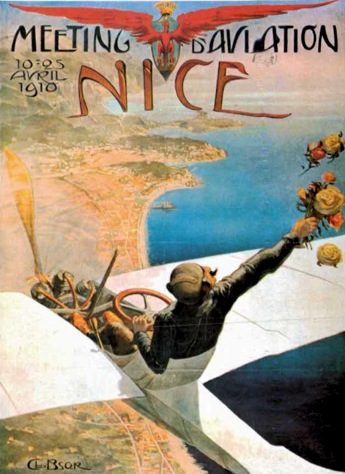


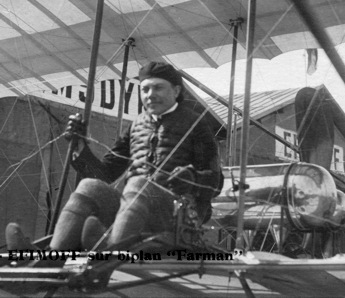
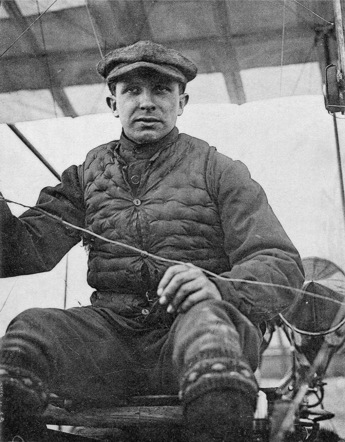
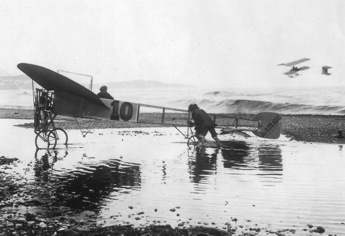

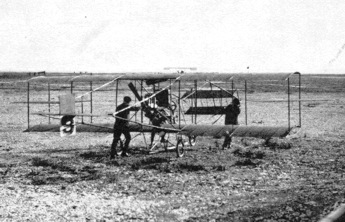
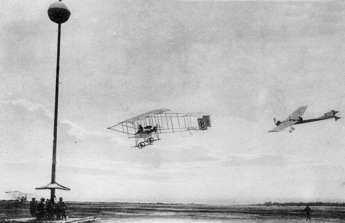



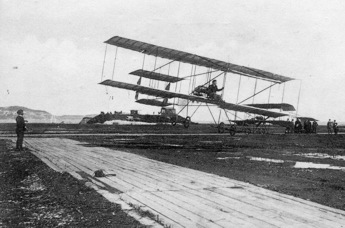
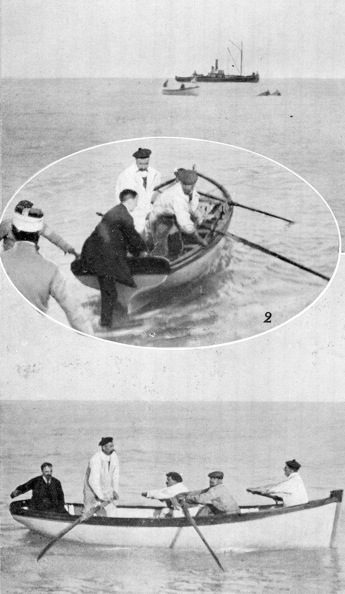
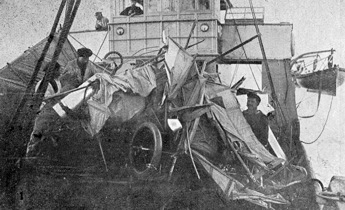

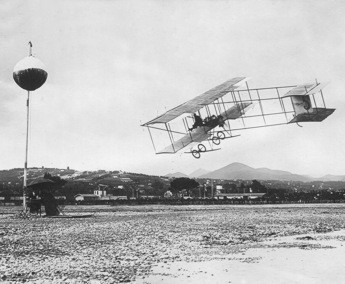



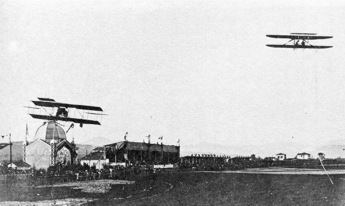

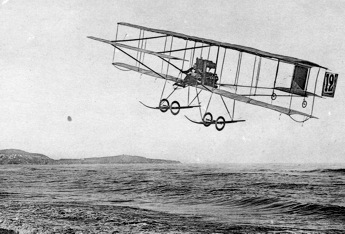




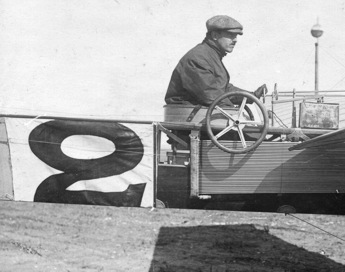
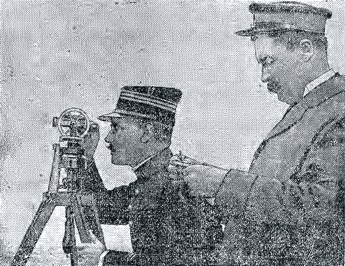

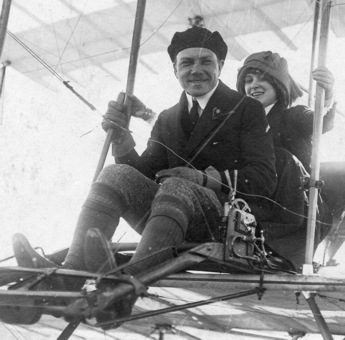




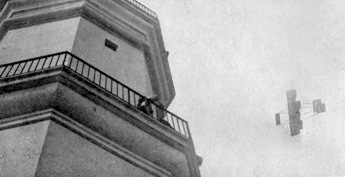

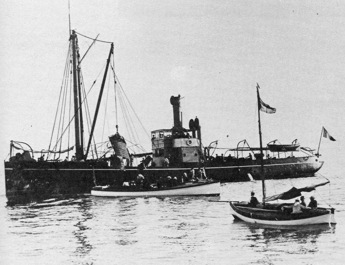
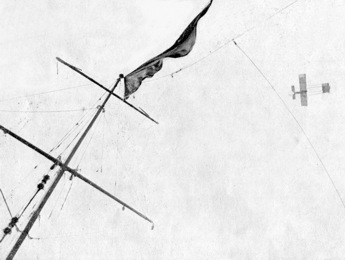


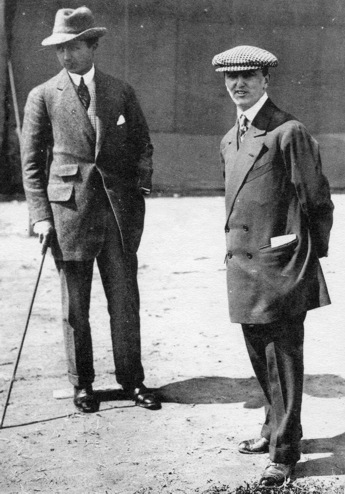

Nice is the capital of the department Alpes-Maritimes,
at the eastern end of the French Riviera. It has for a
long time been a resort for the rich and famous, due to
its mild winter climate and its casinos and beautiful
promenades. In 1910 the town had 130,000 inhabitants and
apart from tourism lived from agricultural produce, such
as oil and fruit. It was also a military town, with
several forts and batteries in the surroundings.
Nice received one of the sanctions for a 1910 meeting
that were granted by the Aéro-Club de France. It was
organized by the town of Nice, with support from the
Aéro-Club de France and the Aéro-Club de Nice. A
committee was formed, headed by M. Sauvan (mayor of
Nice), Albert Gautier (president of the Comité Général
des Sports) and Juste Fernandez (president of the
Aéro-Club de Nice). Like at several other French
meetings, the sporting matters were handled by Marquis de
Kergariou, Paul Rousseau and Ernest Zens from the
Aéro-Club de France. Among the famous people visiting the
meeting were the kings of Sweden and Denmark. US
president Roosevelt was invited, but couldn't take
part.
The budget for the meeting was no less than 800,000
francs, a large part of it provided by the town of Nice.
An enormous lot of work was required in order to make an
airfield of the wet beach flats. Construction of the
airfield installations was delayed by rainy weather and
during the last week preparations were going on around
the clock, in the light of acetylene lamps during the
nights. Sixteen hangars were built, several big
grandstands and a music pavilion, apparently modelled on
the famous casino pier on Promenade Anglais. The price
fund was 215,000 francs. Thirteen flyers entered:
- Charles van den Born (Farman-Gnôme)
- Jorge Chávez (Farman-Gnôme)
- Arthur Duray (Farman-ENV)
- Michel Efimoff (Farman-Gnôme)
- Hans Grade (Grade)
- Hubert Latham (Antoinette)
- René Métrot (Voisin-ENV)
- Jan Olieslagers (Blériot-Anzani)
- Alfred Rawlinson (Farman-Darracq)
- Frederick van Riemsdijk (Curtiss)
- Charles Rolls (Wright)
- Henri Rougier (Voisin-ENV)
- Robert Svendsen (Voisin-Gnôme)
The unfortunate Hubert Le Blon had also entered, but
he was killed when crashing into the harbour of San
Sebastián on 2 April. The big names were the experienced
Latham and Rougier, but Chávez, Métrot and Olieslagers
were also recognized as rising stars. For Efimoff
(Russia), Rawlinson and Rolls (Britain) and Svendsen
(Denmark) it would be the first meeting.
The first planes arrived on the 10th, and by the 13th all
had arrived except Grade's, which was mysteriously
missing en route from Germany. The meeting was preceded
by two further days of bad weather, with high winds and
more rain. During the 13th and 14th the airplanes were
rolled out of their hangars and exhibited to the public,
who paid five francs for seeing them.
Friday April 15th
The first day of the meeting dawned beautifully. The
first to test his wings was Svendsen in his Voisin. He
took off at seven o'clock in the morning, but touched
the ground after a short distance. His main wheels stuck
in the wet sand and brutally stopped the plane. Svendsen
was thrown out of the cockpit, but escaped injury. The
front wheel did its job and prevented the plane from
nosing over, but it took a hard hit and its landing gear
was bent, so the plane had to be towed back to the hangar
for repairs.
Grade's plane finally arrived during the morning,
having been delayed at the railway station of Geneva, and
apart from him everybody was ready except Latham, who had
radiator problems, Duray and Rolls. Rougier and Duray
went for a trip around the course to check the
conditions, but the results can't have been very
encouraging, since the car got stuck in the mud and had
to be helped out. Efimoff and Rougier made short test
flights during around noon.
When the official flights started in the afternoon there
was lots of action, and just as at Cannes a Russian flyer
was at the centre of attention. Before the meeting nobody
had heard much about the young Efimoff and he didn't
speak much French, but he turned out to be the star of
the meeting. He was first in the air when the official
flights started at noon and displayed complete control of
his machine, banking steeply around the pylons, zooming
and side-slipping. In total he made at least seven
flights during the day, the longest of 1 hour 16 minutes.
He won the daily four-lap speed prize and take-off
prizes, both with and without passenger, and with 120
kilometres flown he took the lead in the "Prix de la
totalisation des distances".
Chávez made four flights. The first was interrupted by a
broken rudder wire, which he repaired after landing on
the course. His longest flight was 1 hour 22 minutes. Van
den Born made at least two flights, at first taking wide
tentative turns around the tiny triangular course but
soon finding his lines. He made the day's longest
flight, 87 kilometres in 1 hour 40 minutes. Van den Born
was slightly faster than Chávez, gaining gradually and
finally overtaking him, to the excitement of the crowds.
Métrot made a flight of 25 minutes, during which he left
the field and flew over the countryside. Rougier made two
flights of totally 21 minutes. The hairpin turn at the
east end of the course was difficult in the unwieldy
Voisins and both Rougier and Métrot were reprimanded for
flying above the grandstands.
The grandstands were full of nobility and important
persons. At around three o'clock Gustaf V, the king
of Sweden arrived at the field to the tones of the
Swedish national hymn and he had the pleasure of seeing
four planes in the air at the same time, something that
hadn't happened since the Reims meeting the year
before.
Rawlinson made two flights. The first lasted only half a
lap because of engine and rudder problems, but during the
second of eight minutes he flew wide turns over the sea.
Olieslagers made three short flights, troubled by a
sticking valve in his Anzani engine and also being blown
over the grandstands. Svendsen did two more tests in his
repaired plane during the afternoon, but it didn't
run well and he had trouble making turns. He twice landed
close to the waterline. The second time he ran into a
small ravine and had to be retrieved by car. The first
day of the meeting was a complete success, although
several flyers still hadn't made an appearance.
Saturday April 16th
On the second day the weather was more unsettled, with
changing and gusty winds and some rain during the
morning. This did nothing to improve the condition of the
airfield, large parts of which were covered by puddles.
The second pylon could only be reached by planks.
Once again Efimoff was first to make an official flight.
Rain started to fall again and postponed further action
until 13:15. This was the day for the distance contest
and the first to try was Van den Born. He landed after 15
km, breaking a front skid, which was soon repaired. At
13:56 Chavez took off, but his engine didn't run well
and he landed almost immediately. Efimoff flew five laps
and then Van den Born took off again, this time staying
in the air for 58 minutes. At three o'clock Efimoff
was in the air again and immediately posted the best time
of the day for the speed contest, but without improving
his best time of the day before. He didn't land, but
continued until he ran out of fuel at half past four.
Duray made his first flight, after spending some time
finding an obligatory life-vest big enough. He flew the
four laps for the speed contest, but his time was void
since he had failed to announce the flight in advance to
the race committee. Van Riemsdijk also made his first
flight. Olieslagers' engine still didn't run
well, so he failed to take off despite several tries. At
four o'clock the wind had dropped and Rougier took
off. He didn't go onto the course but stayed high
above the sea, around 300 metres off the beach.
At 16:46 Duray and Van den Born appeared to be heading to
a mid-air collision when they tried to round the second
pylon at low altitude at the same time. Duray saved them
by quickly turning right towards the sea. Olieslagers had
finally cured his engine problems and made a flight of 34
minutes at an altitude of 60-80 metres. The tight turns
were difficult for the Blériot pilot, since the wings and
fuselage blocked the view downwards. Due to several pylon
cuts he was only credited with an official distance of
eight kilometres flown.
Chávez and the indefatigable Efimoff took off again,
trying to make use of the last hour before the 18:30
curfew. Efimoff flew more than 138 kilometres during the
day, increasing his big lead over Van den Born in the
"Prix de la totalisation". Latham finally made
his long-awaited first flight but had to land after only
eight minutes. A manometer joint had worked loose and he
was sprayed with hot water. During the short flight he
had already confirmed that the Antoinette was the fastest
plane at the meeting, the lap times of 1:26 - 1:27 being
around ten seconds shorter than those of the Farmans.
At 17:43 Rawlinson took off and soon found himself in
front of the faster Efimoff, who went to the inside
instead of overtaking high and on the outside as
prescribed. Rawlinson's plane was caught in his
propeller wash and swerved to the right. This drove him
out over the sea and when he tried to quickly get back to
the racing line he lost control and crashed heavily right
on the waterline. He was thrown into the water,
fortunately suffering nothing more than a bruised arm,
but only the tail of the plane remained on the beach
pebbles. The accident happened close to the start-finish
line, so help arrived quickly. The elevator, the lower
wings and the propeller were broken and the engine
drenched, but Rawlinson, after changing to dry clothes
and enjoying a whisky in his hangar to get the taste of
sea-water out of his mouth, hoped that it could be
repaired during the meeting. Efimoff was given a
reprimand by the stewards and fined 100 francs for his
irregular overtaking manoeuvre.
There was still time for a couple of flights. Efimoff
tried for the take-off prizes, winning the non-passenger
prize but not managing to get airborne quickly enough for
the passenger prize. In the last flight of the day Rolls
finally got his Wright into the air, but he returned to
the hangar after half a lap. After the second day Efimoff
led the "Prix de la totalisation" by 269
kilometres against Van den Born's 153 and
Chavez's 125.
Sunday April 17th
The third day started windy, but it didn't discourage
Efimoff who was once again first in the air, only minutes
after the official start, which had been postponed one
hour to one o'clock. Chavez soon followed and he in
turn was followed by Van den Born. There were a couple of
anxious moments when he took off straight onto the racing
line in front of Chávez, but Chávez reacted quickly and
went high to avoid a collision. Van den Born's
mechanics had spent the night replacing the engine, which
suffered from valve problems, but the new one seemed down
on power so Chávez soon overtook him.
When Chávez had flown for an hour and a half his
mechanics started to signal that he should land, but he
kept on. After 1 hour 44 minutes the tank was empty and
the engine stopped. Chávez glided down and made a heavy
landing in a pool of water. He was immediately on his
feet, uninjured but drenched in muddy water, but the
plane was badly damaged. The landing gear, the front
fuselage and the right wings were broken. When asked why
he hadn't landed while the engine ran, Chávez said
that he had wanted to reach the two-hour mark and that he
had trusted that he would be able to glide to safe
landing when he ran out of fuel, but the wind caught
him.
With Van den Born's engine not running well there was
nobody stopping Efimoff from, as usual, taking the speed
prize and the two take-off prizes. For the passenger
prize he had his compatriot Nicolas Popoff, the big money
winner at Cannes, in the passenger seat, his pockets full
of stones to bring him up to the 75 kg minimum weight.
The take-off runs were sensationally short thanks to the
headwind. Olieslagers also made five efforts for the
take-off prize, but his best result of 13.2 metres was
not enough to beat Efimoff's 10.5.
At three o'clock a storm with black clouds and high
winds came down from the north. The wind rose to 12 m/s,
with gusts of 20 m/s. The white flag was hoisted and all
flying stopped. This was no doubt a relief for all flyers
with sick planes, and there were several: Latham's
engine had developed new troubles. Van den Born's new
engine still didn't deliver full power. Métrot's
crew was working on his ENV V-8. Chávez was pleased that
his engine hadn't even received a scratch during the
crash and confident that he could repair his plane during
the meeting. Things looked worse for Rawlinson, whose
plane was completely dismantled.
It would be a long afternoon for the spectators. There
was no action until six o'clock, when the red flag
was briefly hoisted again. Van den Born wanted to fly,
but his engine would have none of it, and then the day
was over. After the success of the first two days this
was a disappointment. Efimoff still led the "Prix de
la totalisation des distances" by 326 km against
Chavez's 203 and Van den Born's 159.
Monday April 18th
The sun was shining again from a cloudless sky, but the
wind from the west was still rather strong when official
flights started at one o'clock. This didn't
discourage Van den Born, who lost only one minute before
taking off, soon followed by Efimoff. The Russian lost
his cap during the take-off, but managed to catch it with
one hand. He then held it between his teeth until the
first turn, where he calmly put it on again! He flew six
laps and took the lead in the daily speed contest, before
landing to make several efforts for the take-off and
passenger contests. Van den Born stayed in the air for 66
minutes, also setting a time for the speed contest. After
landing he only filled his tank before taking off for a
second flight of 69 minutes. When he tried to make a
third start his engine had had enough and a cylinder of
his Gnôme blew off, making a sound like a cannon-shot and
a big hole in the ground where it hit.
At three o'clock Latham took off, but only covered
two laps before his engine started missing. Efimoff, his
confidence obviously sky high, enjoyed himself by making
dives on people along the course. He had already made ten
flights during the day, and more would come.
Around four o'clock there was lots of action on the
airfield. Métrot, who had tried for two days to cure his
engine problems, failed once more to take off. Duray took
off and steered out over the sea, where he circled a
couple of ships and flew along the Promenade des Anglais
before landing. Svendsen took off, but landed after an
uncertain flight of 500 metres. Olieslagers flew a lap,
followed by Rougier and another over-sea flight by Duray.
Rolls took off from his rail and made his longest flight
so far, 11 minutes. His unstable Wright had obvious
problems with the turbulent air and an observer remarked
that his flight looked like a boat rocked by waves.
Olieslagers made several efforts for the take-off prize,
without beating Efimoff's marks, followed by a couple
of laps at 80 to 120 metres. This high flying obviously
spurred Latham, who took off and gradually climbed to 340
metres to the cheers of the enthusiastic crowd. He landed
with his face full of oil from the leaking engine,
stating that the air was very turbulent and that he only
found calm air at 300 metres. Then there was a new loud
bang from the hangars. This time it was one of
Svendsen's cylinders that was blown off, making
another hole in the ground and narrowly missing several
people, among them the king of Sweden.
This was not the end of the day's drama. Just before
five o'clock Rougier took off and steered out over
the sea. Around 100 metres off the beach he lost control
of his Voisin, which rolled to the left and dived into
the sea from an altitude of twenty meters. Rougier had
the presence of mind to cut the ignition before hitting
the water, which he claimed felt as hard as concrete. The
plane soon started sinking and Rougier had to fight hard
to get free. He cut his hand on a broken steel wire while
freeing himself from the collapsed fuselage and while
struggling to get to the surface he got a further cut
above the left eye from the wing rigging. It was a narrow
escape, according to the time-takers he had been below
the surface for more than twelve seconds. Rougier was
fortunately a good swimmer and he set off towards the
beach in order to avoid being pulled down by the sinking
plane. He displayed more presence of mind when he first
got rid of his jacket to swim easier and then changed his
mind when he recalled that this would have meant risking
losing his wallet, which contained 10,000 francs in cash,
the entire payment for his appearance in the meeting, his
pilot's license and his insurance documents! He was
soon picked up by a motor-boat and was driven bleeding by
car to the time-keepers' hut on the gun butt inside
the course. The king of Sweden was once again close to
the action and helpfully recommended that Rougier should
change to dry clothes in order to avoid catching
pneumonia. The wreckage of the plane was saved thanks to
a sailor who jumped into the water and managed to tie a
rope to the engine. Since Rougier had a second plane it
was hoped that he would fly again before the end of the
week.
Olieslagers took off immediately after the accident. The
ex-motorcycle racer had experience from nasty crashes and
wanted to give the spectators something to look at that
would take their minds off the dramatic accident. The day
finished with several passenger flights by Efimoff, whose
performance during the meeting exceeded everything that
had been seen before, prompting observers to state that
the days of practical, reliable and predictable flying
had finally arrived. Altogether he carried seven
different friends, VIPs and reporters as passengers
during a day of almost taxi flying. He also increased his
lead in the "Prix de la totalisation des
distances", now 458 km against Van den Born's
266 and Chavez's 203.
Tuesday April 19
This was another sunny day but the winds were
unpredictable during the morning. The only one to venture
out before the official flying started was Grade, whose
machine was finally ready. He made his first test, a
short straight hop, at 12:15.
The first one to venture out after one o'clock was
Van den Born. His mechanics had worked hard to assemble a
good engine from the two failed ones, but three short
tests showed that something was still missing. Back to
work… Meanwhile Efimoff started, as usual regular as
clockwork. He began by clocking four laps for the daily
speed contest and then stayed in the air for almost 50
minutes.
Latham's engine suffered from ignition troubles and
still didn't run well, but that didn't stop him
from reaching 300 metres during a 50-kilometre flight and
winning the daily speed prize with a new course record.
Rolls' Wright was finally in good shape and at 13:35
he started a flight of almost half an hour. After some
quiet minutes almost everybody flew between two and three
o'clock. Van Riemsdijk flew half a lap and landed
after touching the ground with a wing tip, followed by
Duray, who took second in the speed contest. Efimoff made
several efforts at the take-off prize with and without
passengers and as usual won both of them. Van den Born
made another test, but the engine still didn't run
well and he landed after a few minutes. Olieslagers made
two flights, first four laps trying for the speed prize
and then a flight of some twenty minutes, during which he
climbed to 80-100 metres. Rolls made a flight of some
twenty minutes, flying out over the sea. He was forced
down when one of the propellers started breaking up.
Duray, Olieslagers and Grade made further short
flights.
At 15:40 Van den Born came out again, and this time it
appears his carburetion problems were solved. He stayed
in the air for almost 50 minutes, breaking the monotony
of touring the course by venturing out to sea. Efimoff
and Duray made passenger flights.
Between four and five o'clock there was another
flurry of activity and for more than twenty minutes the
spectators could watch five planes of four different
makes in the sky at the same time: Latham high,
Olieslagers and Grade a bit lower and Efimoff and Van den
Born chasing laps for the distance contest at low level.
Latham several times frightened the spectators by
stopping his engine to glide down from high altitude, but
it always started again so that he could land under full
control. Olieslagers made a heavy landing and broke a
propeller and a wing tip when a wheel got stuck in the
soft ground, but he would soon be up again in his spare
plane.
Duray, Efimoff and Van den Born took off for the third
"Prix des Passagers", this time a distance
contest. Several of the pilots had started to practice
for the cross-water contests of the upcoming weekend. The
most spectacular sea flight so far was made by Duray, who
disappeared from sight, crossed the Baie des Anges,
turned back at Hotel Beau-Rivage in the Old Town and
returned along the Promenade des Anglais to the
excitement of the around 15,000 people watching.
Olieslagers was out in his spare plane and Grade made an
impressive flight at relatively high altitude. Rolls also
started a flight at around half past five.
At 17:45, after flying several laps, Grade found himself
behind one of the Farmans and since his light plane was
disturbed by the wash he decided to land. When about to
touch down he suddenly noticed a group of people in front
and gunned the engine to pass over them. The plane
bounced high into the air with the nose almost vertical,
jumped the wall that separated the airfield from the
river Var and landed on its nose, luckily on a sand bank
in the middle of the river. Grade was unhurt, but the
accident site was separated from the airfield by a wide
arm of the quickly flowing river. A brave seaman,
identified by three different names in three different
Nice newspapers, finally managed to cross the stream in a
little boat and brought Grade to the hangar area, where
help quickly arrived. Grade had married only a week
before the meeting and this was perhaps not what he
expected from the honeymoon! The plane was retrieved in
the moonlight in the evening with the help an improvised
raft and two strong horses. The propeller and the bamboo
beam forming the rear fuselage were broken, but otherwise
the plane appeared to be easily repairable.
As for the other pilots who had suffered accidents,
Rawlinson still had his arm in a sling and was uncertain
about returning to the action. Chávez's crew and
mechanics from local airplane builders Henri Chazal were
working long busy hours repairing his plane. A reporter
colourfully described a person sitting in the
airplane's seat, which had been placed on top of a
fuel canister, sewing fabric onto the rebuilt wings.
Rougier had made a complete recovery and was following
the flying from the balcony of his hotel room. It was
reported that he had decided to rest from flying for a
month after his busy touring during the spring, but he
would never return to competitive flying and announced
his retirement a couple of weeks later.
Efimoff, Van den Born and Rolls were all still in the air
at 18:30 and had to be flagged down. Van den Born's
mechanics were finally rewarded by seeing him win the
"Prix des Passagers" after a flight of 70
minutes. Efimoff was beaten by a mere four laps, but the
155 kilometres that he had flown during the day had once
again increased his lead in the "Prix de
totalisation". He had now reached 614 kilometres,
which was claimed to be a world record for distance
covered during a single meeting. The previous best was
the 569 kilometres scored by Hubert Latham during the
1909 Reims meeting. Van den Born had reached 276 km and
Chavez 203 km.
Wednesday 20 April
This was a perfect day for flying, with light cloud cover
and winds never higher than 3 m/s. Could the astonishing
success of the previous day be repeated?
Latham and Duray had both protested to the race committee
that they had been hindered by slower planes during their
efforts for the Prix du Tour de Piste the day before.
Duray, who had a strong engine in his Farman, even had to
overtake two planes during one of his flights and landed
after three laps to make his protest.
As usual Van den Born and Efimoff were first out, only
minutes after one o'clock. Both made efforts for the
Prix du Tour de Piste and then went on to collect
"frequent flyer miles". Rolls started at 13:36,
also with the same strategy. Speeds were improving, no
doubt as pilots learned the best lines around the tight
turns of the short course. Rolls displayed the
manoeuvring capabilities of the Wright by swooping from
high altitude and flying small circles over the Var.
After two days and nights of hard work after the Sunday
crash Chavez's Farman was ready to fly at 14:08. New
smaller lower wing panels had replaced the original
equal-span wings, which seemed to improve the speed.
Despite a troublesome engine he posted the best time for
the "Prix du Tour de Piste". His lead
didn't last long, however, since Latham soon posted a
record-beating 5:38.8, but it was the best time by a
Farman, beating Duray's time of the day before.
Efimoff made a short break to fill his tank and let the
engine cool down before taking off again. Chavez started
a second flight at 15:15 and covered five laps before
retiring for the day because of engine problems. Latham
took off for a twenty-minute flight, flying high and
above the countryside. Meanwhile, Efimoff made another
landing and took off again. At 15:37 Rolls took off,
having changed propellers. He made two flights, totalling
more than an hour and officially covering 54 kilometres,
despite touring over the sea and having to cut pylons in
order to avoid hindering other planes.
Around four o'clock Métrot finally rolled out his
Voisin after trying for a couple of days to make his
engine run well. The mechanics had apparently been
successful, because he immediately embarked on a
spectacular high flight, eventually reaching 340 metres.
Latham obviously felt that this was a challenge to his
territory and climbed to 250 metres while Métrot made a
quick descent and an elegant landing in front of the
grandstands. Latham stayed in the air for more than an
hour, covering 57 kilometres. The altitude contest would
be held on the next day and Efimoff, who had previously
hardly flown higher than the pylon tops obviously wanted
to play too. He quickly climbed to 175 metres before
landing again, perhaps not wanting to show his hand.
Duray, Efimoff and Olieslagers made efforts for the
take-off contest, but the outcome was the usual: Efimoff
won both with and without passenger. This was the day for
the "Prix des Mecaniciens", a contest of one
lap with standing start. Duray and Efimoff made two
efforts each, with Duray scoring the two best times.
Latham had also entered, but the place where he was
instructed to start was wet and muddy and his wheels got
stuck. The plane started to nose over but was caught by
the nose skid, which dug deeply into the ground. The
propeller hit the ground and broke. As could well be
imagined, Latham was furious and protested to the race
committee for forcing him start in such a bad place. The
damages were fortunately restricted to the propeller and
the nose skid, so after replacing those he would be able
to compete for the altitude prize the day after.
Efimoff and Rolls finished the day's flying. Efimoff,
who again had to be flagged down after the curfew, had
flown 135 kilometres during the day, yet again increasing
his lead in the "Prix de Totalisation". The top
five at the end of the day were Efimoff (750 km), Van den
Born (411 km), Chávez (246 km), Latham (184 km) and Rolls
(157 km).
The organizing committee announced that unawarded prize
money would go towards a "Prix de Mérite" for
the three flyers who had contributed most to the success
of the meeting. They also announced that since the
exhibition of airplanes before the start of the meeting
had been hampered by rain and wind there would be a
similar exhibition on two more afternoons.
Thursday 21 April
The weather was again perfect on the sixth day of the
meeting. The main event of the day would be the
"Prix de l'Altitude", which many in the
crowd regarded as the most exciting event. Endurance
isn't so exciting to watch, and the speeds of around
60-70 km/h were not that mind-blowing, but flying at an
altitude of several hundred meters! In the absence of
world record holder Louis Paulhan everybody expected
Latham in his beautiful Antoinette to win it. Would he
succeed? Paulhan had after all flown a Farman when he set
the record, but Latham had also reached 1,000 metres
before…
Before the start of the day's action the local
restaurant owner M. Roux invited all the flyers for a
five-course luncheon. This was perhaps the reason why
despite the perfect conditions nobody tried their wings
until Latham brought out his plane at 13:35. This flight
could have robbed him of the chance to win the "Prix
de l'Altitude": His landing after a fast six-lap
flight was heavy and just as the day before the main
wheels stuck in the soft ground, the tail started to rise
and the front skid dug in. Fortunately only the propeller
was damaged, but now Latham only had one left. While
Latham flew Rolls took off and made a flight of more than
an hour, setting a time for the "Prix de Tour de
Piste" and making a couple of tours over the
sea.
Duray made three starts, but his engine kept missing and
he never flew more than a single lap. After a quiet
interval Efimoff took off at 15:06 and beat Rolls'
time at the start of a 23-minute flight. Rolls made a
second short flight, then Efimoff tried without success
to improve his time for the "Prix de Tour de
Piste" before once again winning the two "Prix
de Lancement". His passenger was the young wife of a
local press man, who completely enjoyed the experience,
saying it was better than riding a car. For his next
passenger flight he brought General Beaudenom de Lamaze,
commander of the 29th Division, who stated he felt
totally secure during the flight.
Flights for the "Prix de l'Altitude" were
supposed to start at four o'clock, but nobody wanted
to be first. In the end Chávez took off at 16:38,
followed four minutes later by Latham. Chávez circled
ever higher, but Latham's Antoinette climbed faster
and after seven minutes he passed Chávez's Farman at
200 metres and quickly pulled away. Latham had reached
490 metres when a belt broke and the crowds immediately
heard the engine losing power. He quickly pointed the
nose downwards and at 17:15 glided to safe landing,
helped somewhat by the two cylinders that still fired.
Frantic action started in the Antoinette hangar, while
Chávez kept climbing, finally reaching an unofficially
measured 660 metres after a 49-minute climb. He landed at
17:45 after a 67-minute flight, hoping that he had done
enough. He didn't know how high he had been, since
his altimeter only went to 600 metres.
At 17:10 Métrot took off for his effort. He used a
different strategy, making only two wide circles instead
of the many tighter circles of Chávez and Latham. He
reached 235 metres before finding the turbulence too
difficult and abandoning his effort. He went on a tour
over the countryside and the city centre, returning along
the beach promenade to land after 30 minutes. At 17:23
Van den Born took "Le Figaro" reporter Frantz
Reichel for a 15-minute flight. This was the first
passenger flight over the sea and they also finished with
a tour along the promenade and around the airfield.
At 17:30 Efimoff started the engine in order to go for
the "Prix de l'Altitude", but he had hardly
started rolling when a loud bang was heard and his
propeller disintegrated, miraculously without injuring
anybody. Somebody had left a tool on one of the lower
wings and when the plane started moving it fell into the
spinning propeller. There wasn't time for both
replacing the propeller and reaching a competitive
altitude, so Efimoff was out. Rolls also took off at
17:30, climbing to 235 metres before giving up and
landing after 12 minutes. Olieslagers took off at 17:50
and reached 220 meters during three wide tours of the
field before coming down to land.
Latham took off at 17:48 when the broken belt had been
replaced. He climbed quickly, but would he have time to
get high enough in the 42 minutes remaining before the
18:30 curfew? His last lap had to be cut short in order
to pass the line before the deadline and just as the
cannon-shot announced the end of the day the stewards
indicated that he had also unofficially reached 660
metres. Would it be a dead heat? The race committee would
check their measurements before announcing the final
results.
While Latham flew, several other planes were in the air.
Van Riemsdijk, who hadn't flown before during the
day, made a flight of one lap and Grade took out his
repaired monoplane for a two-lap flight. Rolls, Van den
Born, Chávez and Olieslagers all added some laps to their
scores for the "Prix de Totalisation". The top
five at the end of the day were Efimoff (818 km), Van den
Born (433 km), Chávez (286 km), Latham (227 km) and Rolls
(222 km).
Shortly before eight o'clock the official results of
the "Prix de l'Altitude" were finally
announced: Latham had won by a mere twelve metres, the
official results being 656 metres against 644! Chávez
accepted the disappointing decision sportingly and took
the opportunity to thank Van den Born for lending him
some engine parts that had made it possible for him to
fly at all. Small adjustments were also made to the
results of the other three pilots, resulting in Rolls
being elevated to third place. Efimoff announced that he
would try to beat the world altitude record the day
after.
On the following day Latham filed an official protest to
the race committee, accompanied by the required fee of 50
francs. He had heard from one of the stewards that the
margin of error of the measurements was bigger than one
percent, which meant that it wasn't certain that the
results really reflected reality. Latham stated that
since he would himself find it very unpleasant to be the
victim of such circumstances, and being the only one to
have anything to lose, he wanted the results to be
modified taking into account the risk of errors. As a
consequence he would be willing to share the prize money
with Chávez. The committee rejected the protest, simply
stating that the contestants had no right to question the
means employed by the committee for measuring the
results. On such matters the committee was only
responsible to the F.A.I. and the "Commission
Aérienne Mixte".
Friday 22 April
This was the last day of the regular contests, since the
weekend would be devoted to the two over-water
cross-country races. During the morning Van den
Born's mechanics installed a new engine to replace
his previous troublesome example, a work which was
accomplished in two hours. Rawlinson's plane was now
completely repaired, except that he still hadn't
received the propeller, which was being sent by railway
from Paris. Svendsen's hangar was empty. He had
packed his plane and would leave during the afternoon,
probably realizing that he was not ready for meetings
like this. Métrot was also disassembling one of his
planes in order to send it to the upcoming meeting in
Tours. He would not make any flights during the day,
since he still didn't trust his engine.
The weather had turned worse, with strong winds from the
east and dark clouds, and the crowds were not as numerous
as the previous days. The reports in the local newspapers
were not so enthusiastic anymore and some remarked that
the endless flying was not very interesting. Immediately
after the official start at one o'clock Efimoff was
in the air, flying four fast laps for the "Tour de
Piste" contest, followed by a flight of some 50 km.
Chávez, Latham, Van den Born and Rolls followed the same
agenda. Efimoff was far ahead in the total distance
contest, but the others were still fighting for
positions.
Soon after two o'clock Latham made an effort for the
"Prix de tour de piste", easily beating the
previously best time of Efimoff. Around three o'clock
Efimoff made his daily efforts for the take-off prizes,
as usual winning both. Then he made a second effort at
the "Tour de Piste", but the result was no
improvement. Afterwards he returned to the hangar to let
his mechanics check the engine, which he felt didn't
perform well, perhaps an effect of the propeller incident
the day before. Grade in his "flying hammock"
made several short flights in the hard wind, obviously
taking no risks. Around 15:15 several pilots made new
efforts for the "Prix de tour de piste". Van
den Born was first and took the lead. He was followed by
Duray, who beat him by four tenths of a second. Then
Latham, despite the presence of three other planes around
the course, posted a time of 5:41.8, way beyond the
capability of the Farmans. Rolls also flew the four laps,
even though his Wright had no chance in a speed
contest.
At 17:20 Efimoff took off for his promised attack on the
world altitude record, held at 1,269 metres by Louis
Paulhan since the January Los Angeles meeting. He climbed
quickly in large circles to an altitude of 250 metres,
followed by everybody's eyes, but then his engine
started to miss and suddenly stopped. He was far out over
the sea when it failed, but managed to restart the engine
a couple of times and glide down to a safe landing on the
beach, only metres from the waterline. If the failure had
occurred just seconds earlier he had been in for a bath.
This put an end to his flying for the day, but the 887
kilometres that he had flown during the eight days had
already secured the win in the "Prix de
totalisation" by a broad margin.
Latham and Van den Born were still flying lap after lap,
the latter covering a total of 151 km during the day,
which put him in a safe second place. Latham's 91 km
was not enough to demote Chávez from the third place, but
forced him to make an extra flight during the last half
hour of the day. This was made with one of his mechanics
as passenger and his times over 15 km (16:31.0) and 25 km
(25:26.4) were claimed as speed records with
passenger.
Saturday 23 April
The big event of the day was the "cruise" from
the airfield across the Baie des Anges, around the
lighthouse on Cap-Ferrat around six kilometres south-east
of the centre of Nice and back. It was, somewhat
questionably, announced as the first race of its kind,
perhaps based on the fact that at the similar race held
at Cannes three weeks earlier only one competitor had
completed the course. In order to ensure that all flying
around the course was made in the normal anti-clockwise
direction the flyers had to cross the start/finish line
and then round all three pylons before turning towards
the sea. At the finish they also had to round all three
pylons before crossing the line. Flights were allowed
between three o'clock and half past six.
Eight of the flyers announced that they would
participate, while Olieslagers, Grade and Rawlinson
wouldn't. Olieslagers didn't think his light
low-powered Blériot would have a chance. Grade's
propeller shaft had been bent during his crash in the
Var, which made the bearings overheat and limited him to
short flights. Rawlinson had found out that some of his
struts had warped as a result of being dipped in the
water during his crash, and his arm was still in a
sling.
The destroyer "Carabinier" and four French navy
torpedo boats would be stationed along the course, and
several other steamers and motorboats would also be ready
to quickly help flyers who had to ditch. Efimoff, Chávez
and Rolls had made a reconnaissance cruise along the
course aboard the "Carabinier" during the
morning. Rolls and Van Riemsdijk had fitted flotation
bags to their planes. At noon M. Sauvan, mayor of Nice,
offered a five-course luncheon to the race committee and
all the stewards. Crowds estimated at 60,000 to 100,000
spectators lined the airfield and the beaches and
quays.
The first flyer to take off was Duray, but since he would
have jumped the gun he was flagged down by his mechanics
for a new start. Therefore it was Van den Born who was
first out on the course at 15:01, followed exactly one
minute later by Duray. They were followed by Latham at
15:13, visibly faster, and twenty seconds later by Rolls,
who flew much higher than the others. Chávez started at
15:18 and also flew very high. He had flown an extra lap
around the course before starting in order to climb to an
altitude where he felt he would be able to safely glide
close to a ship if his engine failed over sea.
Duray, in his faster machine, overtook Van den Born at
the end of the first leg. Even after losing time with a
wide turn at the lighthouse he was ahead coming back to
the airfield, but he made another bad turn returning to
the airfield and at 15:20 the planes crossed the line
almost at the same time. They both said that there had
been no problems, except that on the return leg, flying
towards the sun, the haze had made it difficult to see
ahead. At 15:30 Latham landed, easily beating the two
Farman pilots with a flight averaging 86 km/h. He was
followed almost five minutes later by Rolls, who declared
that he would make a second effort when the wind
decreased. Chavez landed at 15:35, but his time was only
good enough to beat Rolls. Efimoff was next to start at
15:46. He narrowly beat Chávez but was not satisfied with
his time. Métrot made his start at 16:20. His Voisin
didn't have the speed to compete for the price money
and he flew high and close to the coastline. At 17:08
Efimoff started a second effort, but he had to turn back
halfway on the first leg when his engine started
missing.
Both the race committee and his friends tried to
discourage Van Riemsdijk from flying over the sea, since
his engine didn't run well, but the young Dutchman
didn't want to listen and at 17:18 he made his start.
Already after four kilometres, two kilometres from the
beach, he was in trouble. The engine ran very irregularly
and the machine flew erratically, even touching the water
a couple of times. The "Carabinier" and one of
the torpedo boats speeded towards the crippled plane and
when it finally ditched they were able to quickly rescue
Van Riemsdijk, who was waving to signal that he was all
right. Two boats were launched and fished him out of the
water. Well on board one of the torpedo boats he shouted
instructions to the seamen that they should tie ropes to
the engine of the plane, so that the fragile airframe
wouldn't be damaged. The whole rescue operation took
less than four minutes and the tug "Polyphème"
retrieved the damaged plane soon afterwards. Van
Riemsdijk was bought to the harbour of Nice, where he
thanked his rescuers. He calmly asked for a cigarette and
declared that he wanted to take another bath, unforced
this time, and change clothes, so that he could return
those that the captain of torpedo boat No. 203 had lent
him.
At 17:30 Rolls made his second effort and the lighter
wind and his experience of the course enabled him to
improve his time by some four minutes and beat Duray to
the second prize - it seemed... The next day the race
committee announced that there had been an error in the
timing and that his time was two minutes longer than
originally announced, only good enough for fourth. While
all this was going on, Grade, Olieslagers and Duray made
some short flights around the airfield. Van den Born sold
five passenger flights around the course for 100 francs
each, donating the money to a local campaign for a
monument over the late Ferdinand Ferber, who made several
of his flying experiments very close to the airfield.
It was announced that the meeting would be extended by
one day. On the Monday the pilots could compete for
additional prizes for altitude and total distance, and
the ticket prices would be halved. It was declared a
holiday for the 2,000 children of the schools of Nice and
special trains would carry them to the airfield free of
charge.
Sunday 24 April
This last day of the official meeting dawn beautifully,
with clear sky, a light mist over the sea and almost no
wind. The event of the day would be the over-water race
from the airport to the Garoupe lighthouse at Antibes and
back. When the program for the meeting was first
published it included the option of extending this race
to Cannes and back, but in the end the shorter distance
was chosen. Duray and Van den Born had taken the
precaution of making a car trip to Antibes in order to
have a look at the turning point. A second destroyer, the
"Mousqueton", had joined the fleet of different
craft patrolling.
From the hangars came the news that Efimoff's
mechanics had replaced his all but worn out Gnôme rotary
with a stronger 60 hp ENV V-8. Van den Born had decided
not to participate in the race, since he reckoned he
would have no chance against Latham's Antoinette and
the Farmans with stronger engines than his Gnôme, and he
had other plans, which he didn't announce yet... The
King of Denmark had arrived and joined his Swedish
colleague in the reserved grandstand.
When the official flying started the pilots wasted no
time. Rolls had flown a couple of laps around the course
waiting for the cannon that announced the start and cut
the start line five seconds past three. He was followed 5
seconds later by Chávez and after 20 more seconds by
Latham. En route to Antibes Latham passed both Chávez and
Rolls, thereby winning the prize offered by the town of
Antibes to the flyer who would first turn around the
lighthouse. He passed it at around sixty meters, waving
to the spectators, before disappearing into the mist
again. Rolls won the second prize over Chávez by only
five seconds.
Latham returned to the airfield taking a slight detour
along the coast, posting a time of 20:16.0, which would
stand as the best of the day. Chávez overtook Rolls on
the way home and both landed safely. Latham didn't
land but flew a lap of the course and then immediately
set out on a second flight to Antibes. The second time
was no improvement, but after landing the celebrations
were enormous and he and his mother were taken to the
official tribune, where he was presented to the kings of
Sweden and Denmark.
At 15:40 Métrot took off in his Voisin. He knew that all
the other planes were faster, so he flew a wide high
course and returned safely to the airfield, posting the
slowest time. He was probably looking forward to the
Tours meeting the next weekend, where he would fly the
new "racing type" Voisin. Duray took off at
four o'clock and posted the second best time, of
21:40.4, as usual flying at minimum altitude. During the
afternoon Olieslagers flew several laps around the
airfield and at five o'clock decided to give the
citizens of Nice something to look at by making a long
flight over the city centre, passing the promenade and
the Casino and circling the Place Massena.
At 16:20 Efimoff flew several laps of the course in order
to verify that his new engine installation was in order.
He was followed five minutes later by Chávez, who made
his second cruise. This time Chávez, probably realizing
that he too had no chance of beating Latham or the
ENV-engined Farmans, went for high altitudes. He passed
the lighthouse at 350 metres before climbing to an
estimated 600 metres during the return leg. After some
adjustments Efimoff finally set off at 17:10. He beat
Duray's time by some nine seconds.
Van den Born did not participate in the contest, but at
17:15 he declared that he would instead fly to Monaco and
back. The race committee tried to discourage him,
pointing out that his flight would be in the opposite
direction of the race and that there would be no boats
patrolling his course to pick him up if he fell into the
sea. Van den Born refused to change his plans and set
off, while telephone calls were made to places along his
way to try to find people who could offer help if he was
forced down. After a flight of 38:30 he was back, to the
relief of his wife and everybody else. He stated that he
had had no problems and that he had turned back at the
Oceanographic Museum of Monaco, where there had been some
turbulence.
At 17:22 Rolls made a second effort around the Garoupe,
without improvement, and without landing set off for a
third effort, this time improving his time somewhat. At
six o'clock Efimoff made a second effort. This time
his engine was running better and he came within 28
seconds of Latham's time, beating Duray to the second
place.
At six o'clock Latham took off for a third attempt at
the "cruise". When he hadn't been spotted
from the airfield after fifteen minutes and it was noted
that the two destroyers had turned towards Antibes at
full steam it was realized that he had ditched. Around
400 metres from the lighthouse his propeller had broken,
forcing him to glide to a safe but wet landing. One of
the torpedo boats was first to reach Latham's
floating plane and found him calmly smoking a cigarette,
unharmed but wet to the knees. A dinghy picked him up,
but he gave instructions to tow the plane to the Antibes
harbour rather than try to lift it aboard. The rescue was
signalled to the airfield, where Latham's mother was
relieved to get the news. Including his two failed
attempts to cross the English Channel this was the third
time he had ditched a plane!
Towards the end of the day Duray, Chávez and Efimoff made
several passenger flights, giving a general, some V.I.P.s
and reporters and a couple of Russians royalties their
first flights. The day was finished with a six-course
dinner with fine wines, offered to the flyers by the city
of Nice.
Monday 25 April
Two contests, for total flying time and for altitude, had
been announced for this extra day, which started by a
luncheon at the Roux restaurant for the race committee
and several V.I.P.s together with three of the flyers.
However, the feared mistral struck with winds of up to 20
m/s. No flights were possible and all the school-children
who had been granted a day off to visit the races had to
go home disappointed, having only seen some planes in
their hangars. They particularly didn't get to see
their hero Latham or his plane, since the Antoinette was
disassembled for shipping at Antibes. Rawlinson and
Efimoff kept their machines ready until the end of the
day in case weather improved, but to no avail.
Latham and the "Club Nautique de Nice" had
planned to use the Monday for making the experiment of
using an airplane for reconnaissance over the sea. Latham
would be sent out to look for an "enemy" ship
(the "Carabinier") and signal its position by
dropping a coloured sheet of paper. A red paper would
indicate that the enemy ship was to the west and a blue
paper that it was to the east. A white paper would
indicate that the enemy was already in the bay, and in
that case Latham would indicate the direction by pointing
his plane in that direction. This "very
interesting" experiment was of course stopped by the
wind and by Latham's accident the day before.
Although Efimoff stayed for another day of several
passenger flights the travelling circus quickly packed
their planes to go to the next event - Chávez, Métrot and
Duray to Tours, Latham and Van den Born to Lyon,
Olieslagers to Barcelona, Van Riemsdijk to Palermo and
Grade to Berlin.
Conclusion
The 1910 Nice meeting was a complete success, thanks to
the combination of good weather, competent organization
and several pilots who really wanted to fly as much as
possible. The total distance of the officially recorded
flights was announced as 3,265 kilometres, which by quite
a margin beat the previous highest distance flown during
a meeting, the 2,462 kilometres flown during the 1909
Reims meeting.
Efimoff had flown a total of 960 official kilometres,
which at 60 km/h corresponds to a total flying time of
sixteen hours - not counting his many unofficial flights.
The ever-smiling Russian with his amusing, enthusiastic
but very broken French was the surprise hero of the
meeting, while Latham, the "king of the air",
didn't disappoint his many followers. Van den Born
and Chávez also marked themselves out as competent
pilots, the latter building his reputation as an
high-altitude expert. The dozens of passenger flights
performed during the meeting without incident was also
remarkable.
The small airfield with its short 1.5 kilometre course
with a hairpin turn at one end was criticised by some
pilots and certainly handicapped planes that weren't
manoeuverable enough. Despite the large amounts of money
invested in preparing the airfield it was wet and uneven
in many places. The proximity to the sea was of course
exciting and provided a good view for the spectators, but
six planes ditched and it was lucky that only two pilots
were lightly injured.
The meeting cost enormous sums to organize, and already
while it was going on was predicted that the losses would
be big, but since the Californie airfield is still in
operation it was perhaps a wise decision by the town of
Nice to invest the money.
 Back to the top of
the page
Back to the top of
the page
